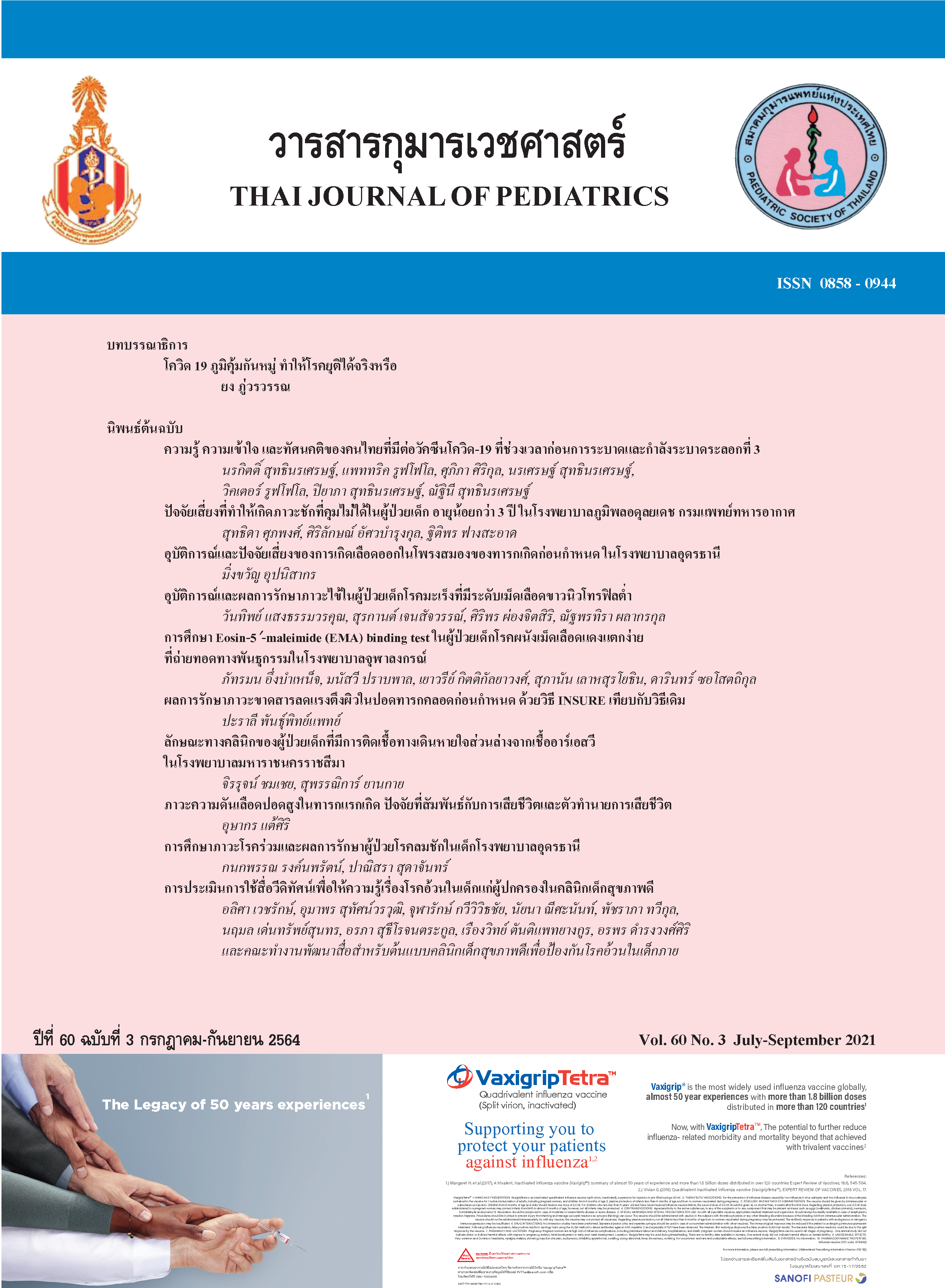ภาวะความดันเลือดปอดสูงในทารกแรกเกิด ปัจจัยที่สัมพันธ์กับการเสียชีวิตและ ตัวทำนายการเสียชีวิต
คำสำคัญ:
PPHN, อุบัติการณ์, อัตราการเสียชีวิต, ปัจจัยที่สัมพันธ์กับการเสียชีวิต, เครื่องมือทำนายโอกาสเสียชีวิต, SNAPPE-IIบทคัดย่อ
บทนำ : ภาวะความดันเลือดปอดสูงในทารกแรกเกิด (Persistent pulmonary bypertension of he newbom,PPHN) เป็นภาวะวิกฤตรุนแรงที่ทำให้เกิดการพร่องออกซิเจน อ่อนไหวมาก และไม่เสถียร จึงมีอัตราการเลียชีวิตสูง อย่างไรก็ตามยังมีความท้าทายและมีช่องว่างของโอกาสพัฒนาประสิทธิภาพการดูแลรักษาเพื่อลดอัตราการเสียชีวิต โดยเฉพาะในกลุ่มที่สาเหตุไม่ได้เกิดจาก pumonary bypoplasia
วัตถุประสงค์ : ศึกษาอุบัติการณ์ในจังหวัดอุบลราชธานี อัตราการเสิยชีวิตโรงพยาบาลสรรพสิทธิประสงค์ปัจจัยที่สัมพันธ์กับการเสียชีวิต และความสามารถในการทำนายโอกาสเสียชิวิตโดยใช้ Score for Neonatal Acute Physiology and Perinatal Extension-2 ( SNAPPE-I)
วิธีการศึกษา : การศึกษาจากเหตุไปหาผลแบบย้อนหลัง (retrospective chor) ของทารกแรกเกิด
ภาระความดันเลือดปอดสูงที่เข้ารักษาในโรงพยาบาลสรรพสิทธิประสงค์ ตั้งแต่วันที่ 1 มกราคม 2559 ถึง 31 ธันวาคม 2562 วิเคราะห์ปัจจัยที่สัมพันธ์กับการเสียชีวิต ความสามารถในการทำนายโอกาสเสียชีวิตของ SNAPPE-I โดย Recciver Operating Charaoteristio (ROC) curve หาพื้นที่ได้โค้งและ sutoff point
ผลการศึกษา : ผู้ป่วยเข้าเกณฑ์การศึกษา 103 ราย เสียชีวิต 60 ราย อัตราการเสียชีวิตของโรงพยาบาลสรรพสิทธิประสงค์รัอยละ 58.3 ทารกเกิดในจังหวัด 88 ราย อุบัติการณ์ของอุบลราชธานิ 1.27 ต่อ 1,000 ทารกเกิดมีชีพ ปัจจัยที่สัมพันธ์กับการเสียชีวิตคือการเกิดก่อนกำหนด (adjusted OR 2.01, 95% C1 1.13-7.54, p-0.028) และการมีภาวะแทรกซ้อน (adjusted OR 5.70, 95% CI 2.08-15.63 p-0.001) SNAPPE-I! มีพิสัย 0-87 มัธฐาน 36 ค่าเฉลี่ย 30 48 23 98 (OS9 CI= 34.03-44.21) และสูงกว่าอย่างมีนัยสำคัญในกลุ่มที่เสียชีวิต (52.83 20.28 Vร. 20.84:14.23, P -0.001) พื้นที่ใด้ไค้ง ROC curve -0.895 คะแนนที่ทำนายดีที่สุด (cutoft point) =35 ความไวร้อยละ 78.3 ความจำเพาะร้อยละ 83.7 อัตราเสี่ยงสัมพัทธ์ 3.6 สรุป : อุบัติการณ์และอัตราการเสียชีวิตของภาวะความดันเลือดปอดสูงในทารกแรกเกิด ยังคงสูงเทียบกับการศึกษาอื่นแต่อัตราการเสียชีวิตลดลงจากการศึกษาเดิมในโรงพยาบาลสรรพสิทธิประสงค์ใน พ.ศ. 2552 ถึง พ.ศ. 2555 ปัจจัยที่สัมพันธ์กับการเสียชีวิตคือการเกิดก่อนกำหนดและ การมีภาวะ
แทรกช้อน SNA PPE-I เป็นเครื่องมือทำนายโอกาสเสียชีวิตที่ดีและง่าย และคะแนนจุดตัดที่มีอำนาจการทำนายที่สุดคือ 35 อัตราเสียชีวิตยังมีโอกาสลดลงได้หากพัฒนาประสิทธิภาพการดูแลรักษาด้าพฤติกรรมและทารกแรกเกิด
Downloads
เอกสารอ้างอิง
Mathew B, Lakshminrusimha S. Persistent Pulmonary Hypertension in the Newborn. Children(Basel). 2017.28;4:63
Walsh-Sukys MC, Tyson JE, Wright LL, et al. Persistent Pulmonary Hypertension in the Newborn in the era Before nitric oxide: practice variation and outcome. Pediatrics. 2000;105:14-20
ฐานัดดา อยู่เกษม. การใช้ยากิน Sildenafil เพื่อรักษาภาวะความดันเลือดปอดสูงในทารกแรกเกิด. กุมารเวชสาร 2552; 16:210-6
พิชญา ถนอมสิงห์. ผลการรักษาภาวะความดันเส้นเลือดในปอดสูงในทารกแรกเกิดอายุครรภ์ 34 สัปดาห์ขึ้นไปในโรงพยาบาลมหาราชนครราชสีมา. เวชสารโรงพยาบาลมหาราช นครราชสีมา 2554; 35/1: 31-43
อุกฤษฎ์ จิระปิ ติ, วรางคณา มหาพรหม. ลักษณะทางคลินิกของผู้ป่วยทารกแรกเกิดที่มีภาวะความดันโลหิตในปอดสูงในโรงพยาบาลเชียงรายประชานุเคราะห์.เชียงรายเวชสาร 2557; 6/1:57-66
นพวรรณ พงศ์โสภา. ภาวะความดันเลือดปอดสูงในทารกแรกเกิดในโรงพยาบาลสรุ าษฎร์ธานี. วารสารวิชาการแพทย์เขต 11 2560;31: 49-59
ชรินพร พนาอรุณวงศ์. ภาวะความดันเลือดปอดสูงในทารกแรกเกิด ในโรงพยาบาลนครพนม. วารสารโรงพยาบาลนครพนม 2561 ;4:5-18
สุรัสวดี พิทักษ์ลิมนุวงศ์. การศึกษาทางคลินิก ของทารกแรกเกิดที่มีภาวะความดันเลือดในปอดสูงแต่กำเนิดในโรงพยาบาลหาดใหญ่. งานวิจัยในการศึกษาและฝึกอบรมเพื่อวุฒิบัตรแสดงความรู้ความชำนาญในการประกอบวิชาชีพเวชกรรม สาขากุมารเวชศาสตร์ ของแพทยสภา พ.ศ. 2557
อุษากร แต้ศิริ. อัตราการเสียชีวิตและปัจจัยที่สัมพันธ์กับการเสียชีวิตของทารกแรกเกิดที่มีภาวะความดันเลือดปอดสูง ในโรงพยาบาลสรรพสิทธิประสงค์. งานวิจัยในการศึกษา และฝึกอบรมเพื่อวุฒิบัตร แสดงความรู้ความชำนาญ สาขากุมารเวชศาสตร์ ของแพทยสภา พ.ศ. 2556
Richardson DK, Corcoran JD, Escobar GJ, Lee SK. SNAP-II and SNAPPE-II: simplified newborn illness severity and mortality risk scores. J.Pediatr.2001;138 :92–100.
Richardson DK, Gray JE, McCormick MC, Workman K, Goldmann DA. Score for Neonatal Acute Physiology: a physiologic severity index for Neonatal intensive care.Pediatrics. 1993;91:617-23.
Zupancic JA, Richardson DK, Horbar JD, et al.Revalidation of the Score for Neonatal Acute Physiology in the Vermont Oxford Network. Pediatrics. 2007;119:156–63.
S, Groer M, Shelton MM, Maguire D, Ashmeade T. A Systematic Review: The Utility of the Revised Version of the Score for Neonatal Acute Physiology Among Critically Ill Neonates. J Perinat Neonatal JPN.000000 0000000135
Harsha SS, Archana BR. SNAPPE-II (Score For Neonatal Acute Physiology withPerinatal Extension-II) in Predicting rtality and Morbidity in NICU. J Clin Diagn Res. 2015;9:SC10-SC12
Bender GJ, Koestler D, Ombao H, et al. Neonatal intensive care unit: predictive models for length of stay. J Perinatol. 2013;33:147–153.doi:10.1038/jp.2012.62
Radfar M, Hashemieh M, Fallahi M, et al. Utilization of SNAP II and SNAPPE II Scores for Predicting the Mortality Rate Among a Cohort of Iranian Newborns. ArchIran Med. 2018;21:153-57
Thimoty J, Hilmanto D, YuniatiT, Score for Neonatal Acute Physiology Perinatal Extension II (SNAPPE II) as the predictor of neonatal mortality hospitalized in Neonatal intensive care unit. Paediatr Indones. May 2009;49: 155-59
Dammann O, Naples M, Bednarek F, et al. Study Investigators. SNAP-II and SNAPPE-II and the risk of structural and functional brain disorders in extremely low gestational age newborns: the ELGAN study. Neonatology. 2010;97:71- 82.
Bhatt D, Travers C, Patel RM, et al. Predicting Mortality or Intestinal Failure in Infants with Surgical Necrotizing Enterocolitis. J Pediatr. 2017;191:22–27.e3.
Fortes Filho JB, Dill JC, Ishizaki A, Aguiar WW, Silveira RC, Procianoy RS. Score forNeonatal Acute Physiology and Perinatal Extension II as a predictor of retinopathy of prematurity: study in 304 very-low-birth-weight preterm infants. Ophthalmologica. 2009;223:177-82.
Siddappa AM, Quiggle GM, Lock E, Rao RB. Predictors of severe intraventricular hemorrhage in preterm infants under 29- week gestation. J Matern Fetal Neonatal Med. 2021;34:195-200.
Naunova-Timovska S, Jordanova O, Babinkostova Z. Using Score for NeonatalAcute Physiology Perinatal Extension II (SNAPPE II) in Neonates with Acute Kidney Injury. Open Access Maced J Med Sci. 2019 Sep 14;7:3559-3563.
กองยุทธศาสตร์และแผนงาน กระทรวง สาธารณสุข. สถิติสาธารณสุข พ.ศ. 2562; 2563
Steurer MA, Jelliffe-Pawlowski LL, Baer RJ, Partridge JC, Rogers EE, Keller RL. Persistent Pulmonary Hypertension of the Newborn in Late Preterm and Term Infants in California. Pediatrics. 2017 ;139:
Nakanishi H, Suenaga H, Uchiyama A on behalf of The Neonatal Research Network Japan, et al. Persistent pulmonary hypertension of the newborn in extremely preterm infants: a Japanese cohort study. Arch Dis Child-Fetal Neonatal Ed.2018;103: F54-61
Nair J, Lakshminrusimha S. Update on PPHN:mechanisms and treatment. Semin Perinatol. 2014;38:78-91
Benjamin D. Reed, Shreyas Arya, Kevin R. Dufendach and Daniel Leino. Case 2: Refractory Respiratory Failure and Pneumothorax in a Full-Term Newborn. NeoReviews. February 2018, 19 e109- e111;
Bhaktharaj P. Chelliah, David Brown, Morris Cohen, Andre J. Talleyrand and Susan Shen Schwarz. Alveolar Capillary Dysplasia-A Cause of Persistent Pulmonary Hypertension Unresponsive to a Second Course of Extracorporeal Membrane Oxygenation. Pediatrics December 1995;961159-1161
Miranda J, Rocha G, Soares H, Vilan A., Brandão O, Guimarães, H. (2013). Alveolar Capillary Dysplasia with Misalignment of Pulmonary Veins (ACD/ MPV):A Case Series. Case reports in critical care, 2013,327250.
Bishop NB, Stankiewicz P, Steinhorn RH. Alveolar capillary dysplasia. Am J Respir Crit Care Med. 2011;184:172-9.
Delaney C, Cornfield DN. Risk factors for persistent pulmonary hypertension of the newborn. Pulm Circ. 2012;2:15-20.
Roofthooft MT, Elema A, Bergman KA, Berger RM. Patient characteristics in persistent pulmonary hypertension of the newborn. Pulm Med. 2011; 2011:858154.
de Boode WP, Singh Y, Molnar Z, et al. Application of Neonatologist Performed Echocardiography in the assessment and management of persistent pulmonary hypertension of the newborn. Pediatr Res. 2018;84(Suppl 1):68-77
Bhattacharya S, Sen S, Levy PT, Rios DR. Comprehensive Evaluation of Right Heart Performance and Pulmonary Hemodynamics in Neonatal Pulmonary Hypertension : Evaluation of cardiopulmonary performance in neonatal pulmonary hypertension. Curr Treat Options Cardiovasc Med. 2019; 21:10.
ดาวน์โหลด
เผยแพร่แล้ว
รูปแบบการอ้างอิง
ฉบับ
ประเภทบทความ
สัญญาอนุญาต

อนุญาตภายใต้เงื่อนไข Creative Commons Attribution-NonCommercial-NoDerivatives 4.0 International License.



